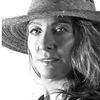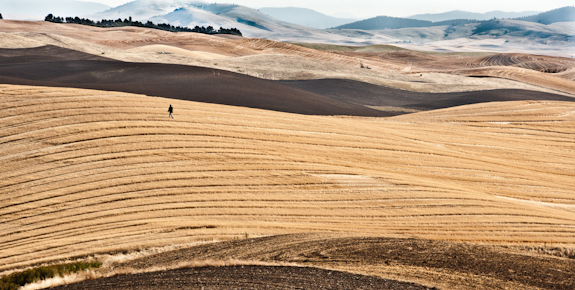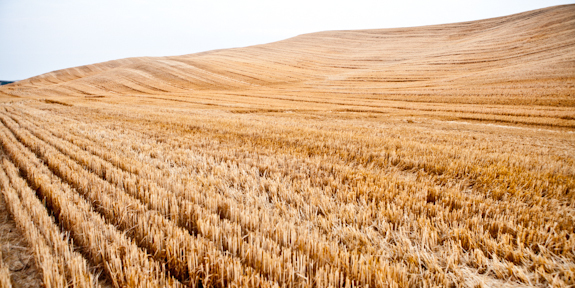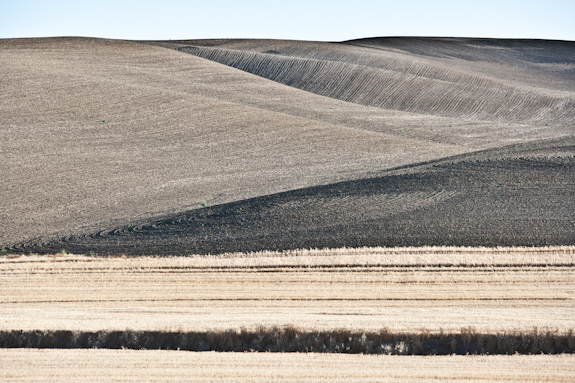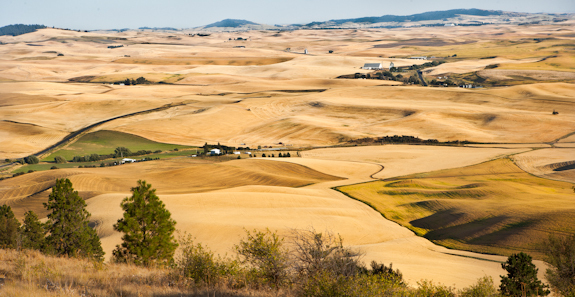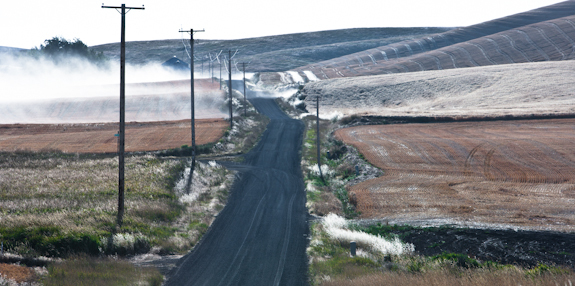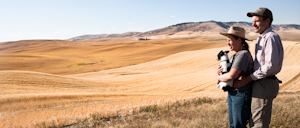
Entering The Palouse, east of everything in Washington state, we crossed an invisible barrier where dunes suddenly appear. A hypnotic place, breathtaking, but not because of dunes of sand... it's the Sahara Desert rendered in wheat. Every curve frames another wave of wheat-dunes within wheat-dunes, stretching as far as the eye can see, bathed in the last rays of light kissing the tips of the freshly harvested crop.
A photographer's dream-scape, we stop the car repeatedly to capture the exquisite vastness. We also realize an unforgettable stillness, a surround-sound of no sound. The scene becomes unreal as the sunlight fades and is replaced by the moon. The air itself... breathless.
Adjacent to the road is a 360 degree mono-crop panorama, glorious in its visual character, frightening in the sprawl of its ecological impact. Stripped bare of life except for the beheaded wheat stalks, is an unrequited balance between industrial farming and the natural world.
Lee brought us here for the scenography discovered on motorcycle trips, but we've also discovered the Zakarison Partnership, a 1200 acre family farm in a region dominated by 16,000 - 20,000 acre industrial farms. Eric and Sheryl Zakarison are causing a stir with their commitment to transforming the business from conventional to organic.
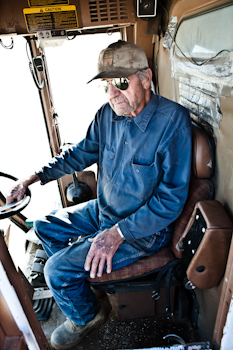 The Zakarison's have worked their wheat fields with patriarch Russell, since the farm's founding in 1935. Though sympathetic to his father's struggles, progress and success, Eric has a different vision...one of an ecologically sound legacy. His goal is to re-establish the health of his land, to "pass through" the health of the soil to the health of his family, to "pass on" the land's wealth through its vitality.
The Zakarison's have worked their wheat fields with patriarch Russell, since the farm's founding in 1935. Though sympathetic to his father's struggles, progress and success, Eric has a different vision...one of an ecologically sound legacy. His goal is to re-establish the health of his land, to "pass through" the health of the soil to the health of his family, to "pass on" the land's wealth through its vitality.
"My goal for the next generation is to leave them with a system where they can still be successful raising food," Eric explains.
Eric's desire grows from his pessimistic opinion of the industrial based systems that dominate The Palouse. "We turn oil into food," he notes, "I can't see the industrial system holding up over time as we reach peak oil. How will the farmers power all those big toys...everything comes to us on a truck. The locals don't want to talk about it; they look down at their shoes if the subject comes up."
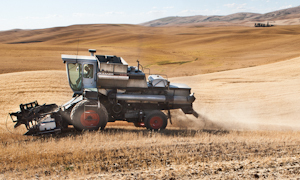 His answer: transforming the farm by producing food with less energy input. For Eric, this starts with selling locally. While 85% of the soft white wheat produced in The Palouse is shipped to Asia, Eric's barley is marketed to small farms in the region. He also sells grain locally for feed, as well as poultry, eggs and lamb. Sustainability = local = economical in this case as his feed only costs 10 cents/bushel for transportation vs. 50 cents/bushel to ship to Portland.
His answer: transforming the farm by producing food with less energy input. For Eric, this starts with selling locally. While 85% of the soft white wheat produced in The Palouse is shipped to Asia, Eric's barley is marketed to small farms in the region. He also sells grain locally for feed, as well as poultry, eggs and lamb. Sustainability = local = economical in this case as his feed only costs 10 cents/bushel for transportation vs. 50 cents/bushel to ship to Portland.
Five years ago, Eric & Sheryl began a phased conversion of a portion of the farm to organics. Critical to success was restoring the health of the soil through a five to eight year rotation of crops instead of the typical three-year rotation.
"Our rotation could include a perennial legume like alfalfa for guarantied coverage, grain crops without herbicides, a green manure crop, then another grain crop, then start over. I expect it to take four to five years to restore the lost fertility in the soil."
This conversion is part of a study directed by John Reganold of Washington State University and is partially funded by a USDA grant supporting organic transition. Eric is also eying a 175 acre section that has been in a Conservation Reserve Program for a number of years. "As this property comes out of conservation, it is a good candidate for an organic approach because no chemicals have been used on it for 15 years," he explains.
Fascinated by The Palouse Prairie region, we needed to know how this landscape came to be and how it came to be so thoroughly exploited.
"The Palouse is a dry steppe climate," Eric explains. "With 21-22 inches of rainfall a year and no irrigation for large-scale vegetable production, a grass and grain based system was a natural fit. In the early 1900's, there was more diversity including pastures for draft animals, but consolidations and government policies created large-scale industrial farming after WWII."
"During the depression, the family almost lost the farm, but after the war petrochemical fertilizers and pesticides were miracles that increased productivity and made The Palouse one of the largest providers of dry-land wheat."
Coming from this cultural/economic background and after farming for 77 years, Russell Zakarison is "...bemused by going organic."
Eric believes that the industrial farmers are challenged by small organic farmers. He feels this with only one local farmer as a customer for pasture raised poultry. Their petrochemical over-spray also makes it difficult to prevent inadvertent contamination.
For over 60 years, the chronic use of inorganic fertilizers and chemicals has poisoned the Palouse's eco-system food chain. This has far reaching impact as toxic soil runoff spreads through the Columbia River watershed. The extensive industrial farming has caused other adverse effects such as loss of topsoil and erosion.
Two to three decades are their timeframe to make the transition.
Eric's simple motto says it all: "farming beyond me," are the watchwords he lives by.
